1994 CADILLAC ELDORADO tire type
[x] Cancel search: tire typePage 196 of 398
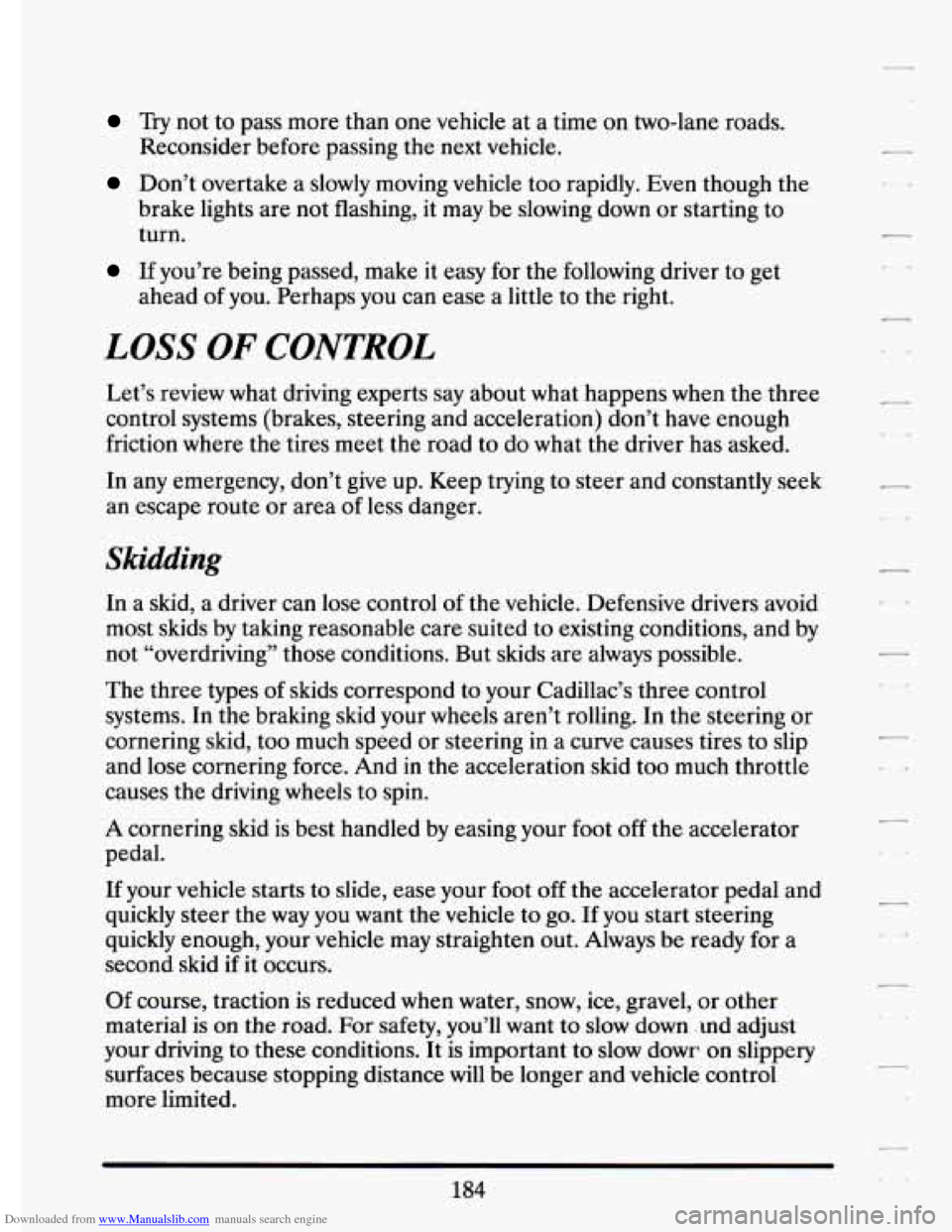
Downloaded from www.Manualslib.com manuals search engine Try not to pass more than one vehicle at a time on two-lane roads.
Reconsider before passing the next vehicle.
Don’t overtake a slowly moving vehicle too rapidly. Even though the
brake lights are not flashing, it may be slowing down or starting to
turn.
If you’re being passed, make it easy for the following driver to get
ahead
of you. Perhaps you can ease a little to the right.
LOSS OF CONTROL
Let’s review what driving experts say about what happens whe\
n the three
control systems (brakes, steering and acceleration) don’t ha\
ve enough
friction where the tires meet the road to do what the driver has asked.
In any emergency, don’t give up. Keep trying to steer and constantly seek
an escape route or area of less danger.
Skidding
In a skid, a driver can lose control of the vehicle. Defensive drivers avoid
most skids by taking reasonable care suited to existing conditions, and by
not “overdriving” those conditions. But skids are always possible.
The three types of skids correspond
to your Cadillac’s three control
systems. In the braking skid your wheels aren’t rolling.
In the steering or
cornering skid, too much speed or steering
in a curve causes tires to slip
and lose cornering force. And in the acceleration skid too much throttle
causes the driving wheels to spin.
A cornering skid is best handled by easing your foot off the accelerator
pedal.
If your vehicle starts to slide, ease your foot off the accelerator pedal and
quickly steer the way you want the vehicle
to go. If you start steering
quickly enough, your vehicle may straighten out. Always be ready for a
second skid if it occurs.
Of course, traction is reduced
when water, snow, ice, gravel, or other
material is on the road. For safety, you’ll want
to slow down .md adjust
your driving
to these conditions. It is important to slow dowr on slippery
surfaces because stopping distance will be longer and vehicle control
more limited.
184
Page 216 of 398
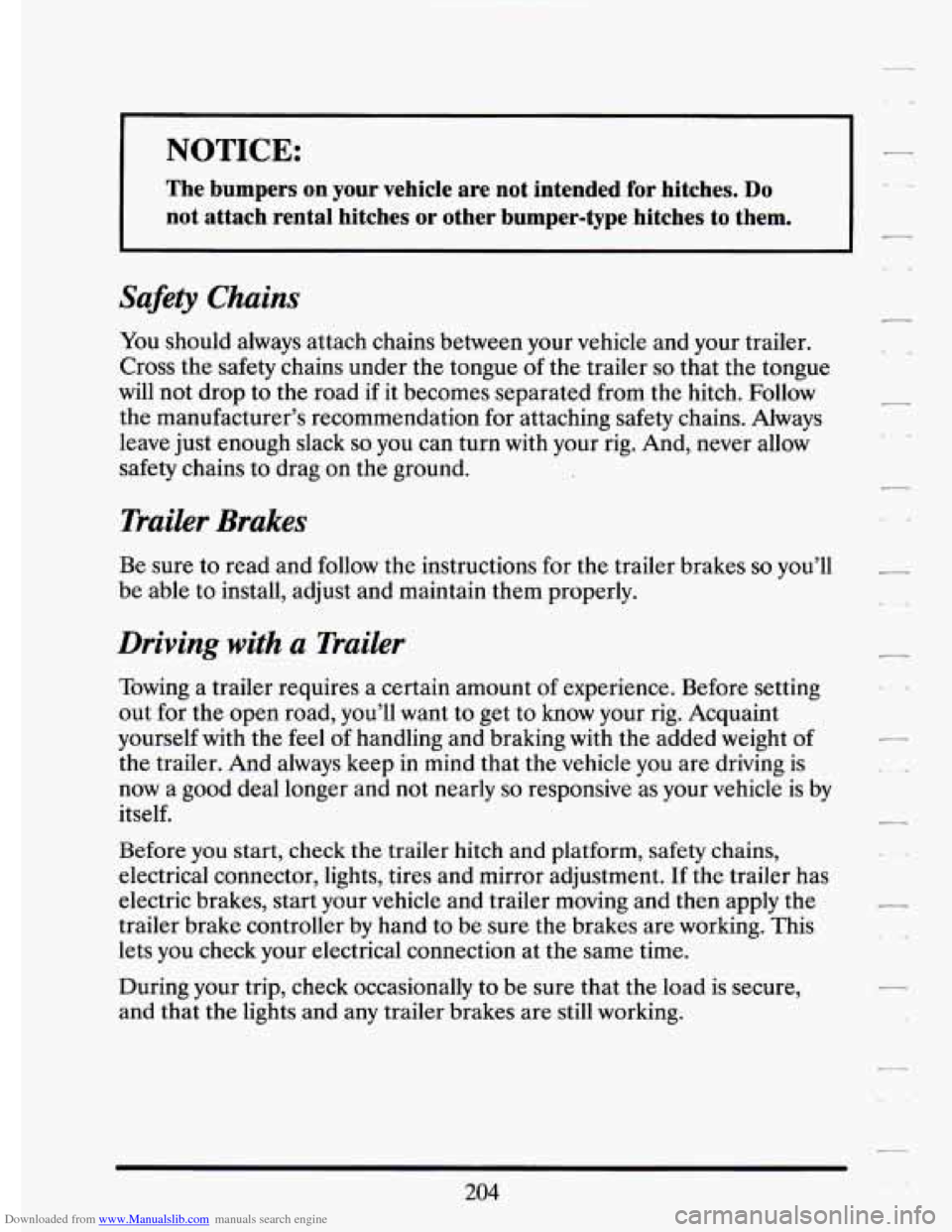
Downloaded from www.Manualslib.com manuals search engine NOTICE:
The bumpers on your vehicle are not intended for hitches. Do
not attach rental hitches or other bumper-type hitches to them.\
-
Safety Chains
You should always attach chains between your vehicle and your trailer.
Cross the safety chains under the tongue of the trailer
so that the tongue
will not drop to the road
if it becomes separated from the hitch. Follow
the manufacturer’s recommendation for attaching safety chains. Alwa\
ys
leave
just enough slack so you can turn with your rig. And, never allow
safety chains to drag on
the ground.
Trailer Brakes
Be sure to read and follow the instructions for the trailer brakes so you’ll -
be able to install, adjust and maintain them properly. L:
Driving with a Trailer
Towing a trailer requires a certain amount of experience. Before setting
out for the open road, you’ll want to get to know your rig. Acquaint
yourself with the feel of handling and braking with the added weight of
the trailer. And always keep in mind that the vehicle you are driving is
now a good deal longer and not nearly
so responsive as your vehicle is by
itself.
Before you start, check the trailer hitch and platform, safety chains,
electrical connector, lights, tires and mirror adjustment. If the trailer has
electric brakes, start your vehicle and trailer moving and then apply the
trailer brake controller by hand to be sure the brakes are working. This
lets you check your electrical connection at the same time.
During your trip, check occasionally to be sure that the load is secure,
and that the lights and any trailer brakes are still working.
204
Page 229 of 398
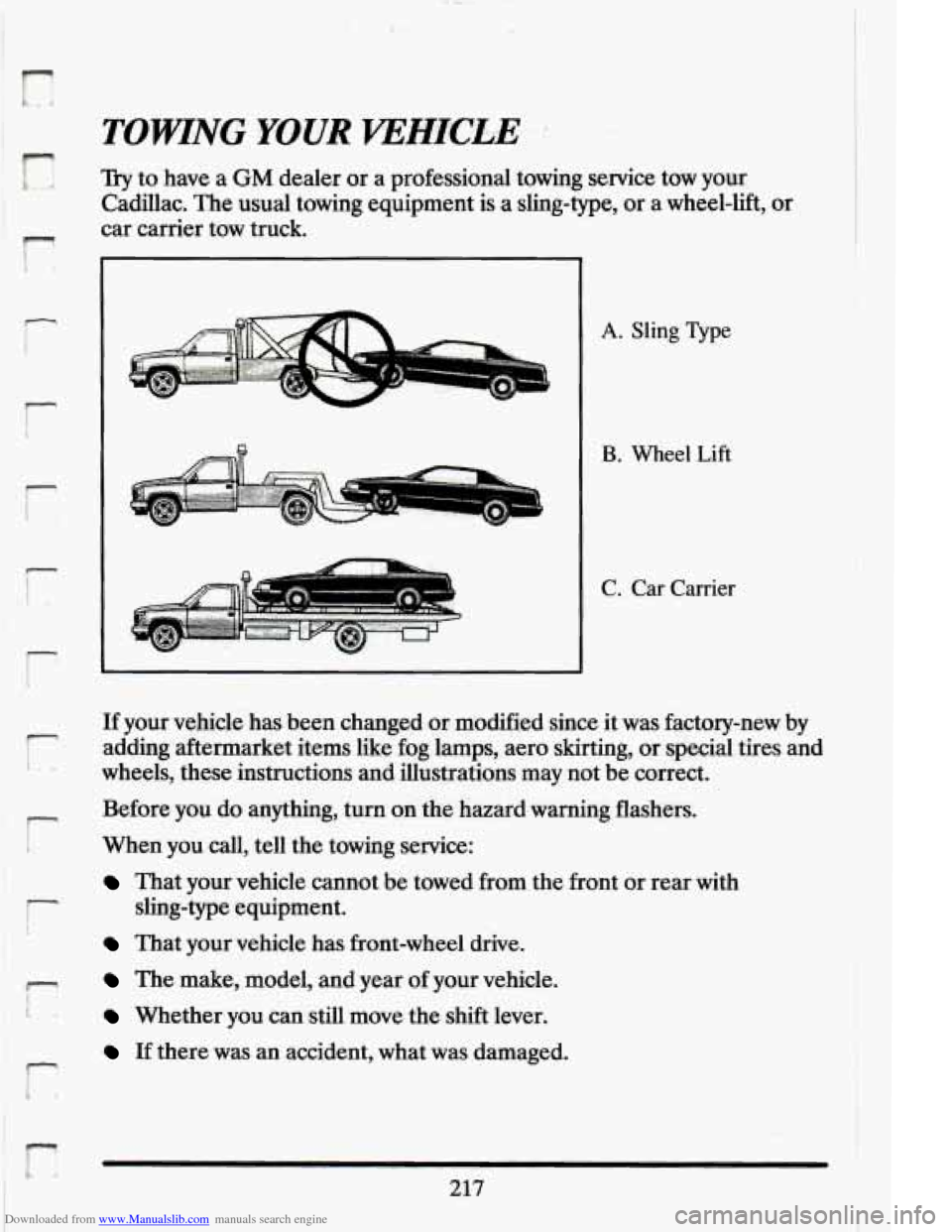
Downloaded from www.Manualslib.com manuals search engine TOWING YOUR VEHICLE
r, Try to have a GM dealer or a professional towing service tow your
Cadillac. The usual towing equipment is a sling-type, or a wheel-lift, or
car carrier tow truck.
r
r
V
I n
t
ir
I 'r:
F-
i
17
r
A. Sling Type
B. Wheel Lift
C. Car Carrier
If your vehicle has been changed or modified since it was factory-new by
adding aftermarket items like fog lamps, aero skirting, or special tires and
wheels, these instructions and illustrations may not be correct.
Before you do anything, turn on the hazard warning flashers.
When you call, tell the towing service:
That your vehicle cannot be towed from the front or rear with
That your vehicle has front-wheel drive.
The make, model, and year of your vehicle.
Whether you can still move the shift lever.
If there was an accident, what was damaged.
sling-type
equipment.
217
Page 303 of 398
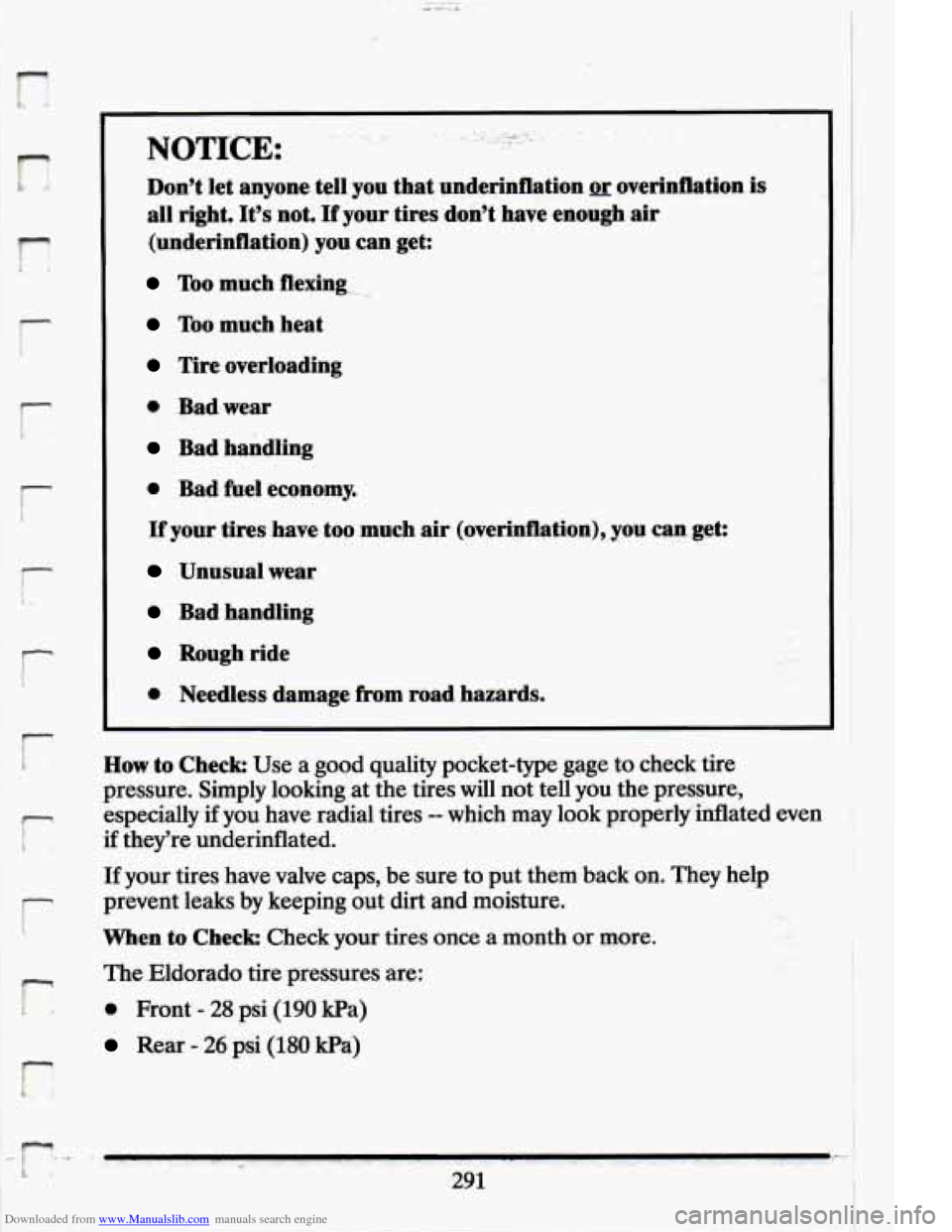
Downloaded from www.Manualslib.com manuals search engine i
NOTICE:
.. - , .., .. . **:. 7 ' . ..._ ^ . ,
Don't let anyone tell you that underinflation or overinflation is
all right. It's not. If your tires don't have enough air
(underinflation) you can get:
Too much flexing.,
Too much heat
Tire overloading
0 Badwear
Bad handling
0 Bad fuel economy.
If your tires have too much air (overinflation), you can ger:
Unusual wear
Bad handling
Rough ride
0 Needless damage from road hazards.
How to Check
Use a good quality pocket-type gage to check tire
pressure. Simply looking at the tires will not tell
you the pressure,
especially
if you have radial tires -- which may look properly' inflated even
if they're underinflated.
If your tires have valve caps, be sure to put them back on. They help
prevent leaks by keeping out dirt and moisture.
When to Check Check your tires once a month or more.
The Eldorado tire pressures are:
0 Front - 28 psi (190 Pa)
Rear - 26 psi (180 kPa)
Page 306 of 398

Downloaded from www.Manualslib.com manuals search engine The tire has a bump, bulge or split.
The tire has a puncture, cut, or other damage that can’t be repaired
well because
of the size or location of the damage.
Buying New Tires
To find out what kind and size of tires you need, look at the Tire-Loading
Information label.
The tires installed on your vehicle when it was new had a Tire
Performance Criteria Specification (TPC Spec) number on each tire’s
sidewall. When you get new tires, get ones with that same
TPC Spec
number. That way, your vehicle
will continue to have tires that are
designed to give proper endurance, handling, speed rating, traction, ride
and other things during normal service
on your vehicle. If your tireshave
an all-season tread design, the TPC number will be followed by a
“MS”
(for mud and snow).
If you ever replace your tires with those not having a TPC Spec number,
make sure they are the same size, load range, speed rating and
construction type (bias, bias-belted or radial) as your original tires.
Uniform Tire Quality Grading
The following information relates to the system developed by the United
States National Highway Traffic Safety Administration which grades tires
294
Page 308 of 398
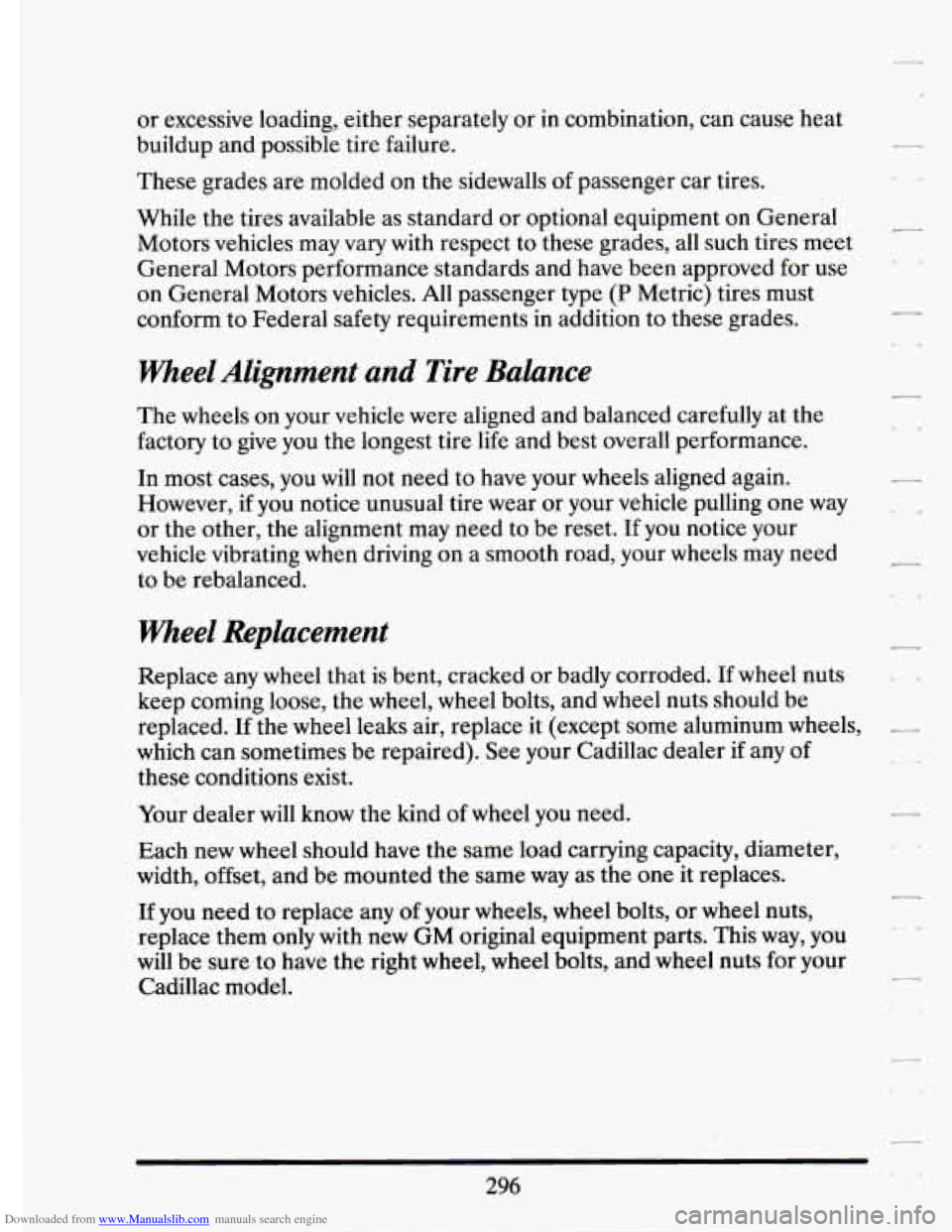
Downloaded from www.Manualslib.com manuals search engine or excessive loading, either separately or in combination, can cause heat
buildup and possible tire failure.
These grades are molded on
the sidewalls of passenger car tires.
While the tires available as standard or optional equipment on General
Motors vehicles may vary with respect to these grades, all such tires meet
General Motors performance standards and have been approved for use
on General Motors vehicles. All passenger type
(P Metric) tires must
conform to Federal safety requirements
in addition to these grades.
Wheel Alignment and Tire Balance
The wheels on your vehicle were aligned and balanced carefully at the
factory to give you the longest tire life and best overall performance.
In most cases, you
will not need to have your wheels aligned again.
However,
if you notice unusual tire wear or your vehicle pulling one way
or the other, the alignment may need to be reset. If you notice your
vehicle vibrating when driving
on a smooth road, your wheels may need
to be rebalanced.
Wheel Replacement
Replace any wheel that is bent, cracked or badly corroded. If wheel nuts
keep coming loose, the wheel, wheel bolts, and wheel nuts should be
replaced. If the wheel leaks air, replace it (except some aluminum wheels,
__
which can sometimes be repaired). See your Cadillac dealer if any of
these conditions exist.
Your dealer will know the kind
of wheel you need.
Each new wheel should have the same load carrying capacity, diameter,
width, offset, and be mounted the same way as the one it replaces.
If you need to replace any of your wheels, wheel bolts, or wheel nuts,
replace them
only with new GM original equipment parts. This way, you
will be sure to have the right wheel, wheel bolts, and
wheel nuts for your
Cadillac model.
296
Page 310 of 398

Downloaded from www.Manualslib.com manuals search engine Tire Chains
NOTICE:
Use tire chains only where legal and only when you must. Use
only
SAE Class “S” type chains that are the proper size for your
tires. Install them on the front tires and tighten them as tightly
as possible with the ends securely fastened. Drive slowly and
follow the chain manufacturer’s instructions.
If you can hear
the chains contacting your vehicle, stop and retighten them.
If
the contact continues, slow down until it stops. Driving too fast
with chains on will damage your vehicle.
APPERACE CARE
298
Page 312 of 398
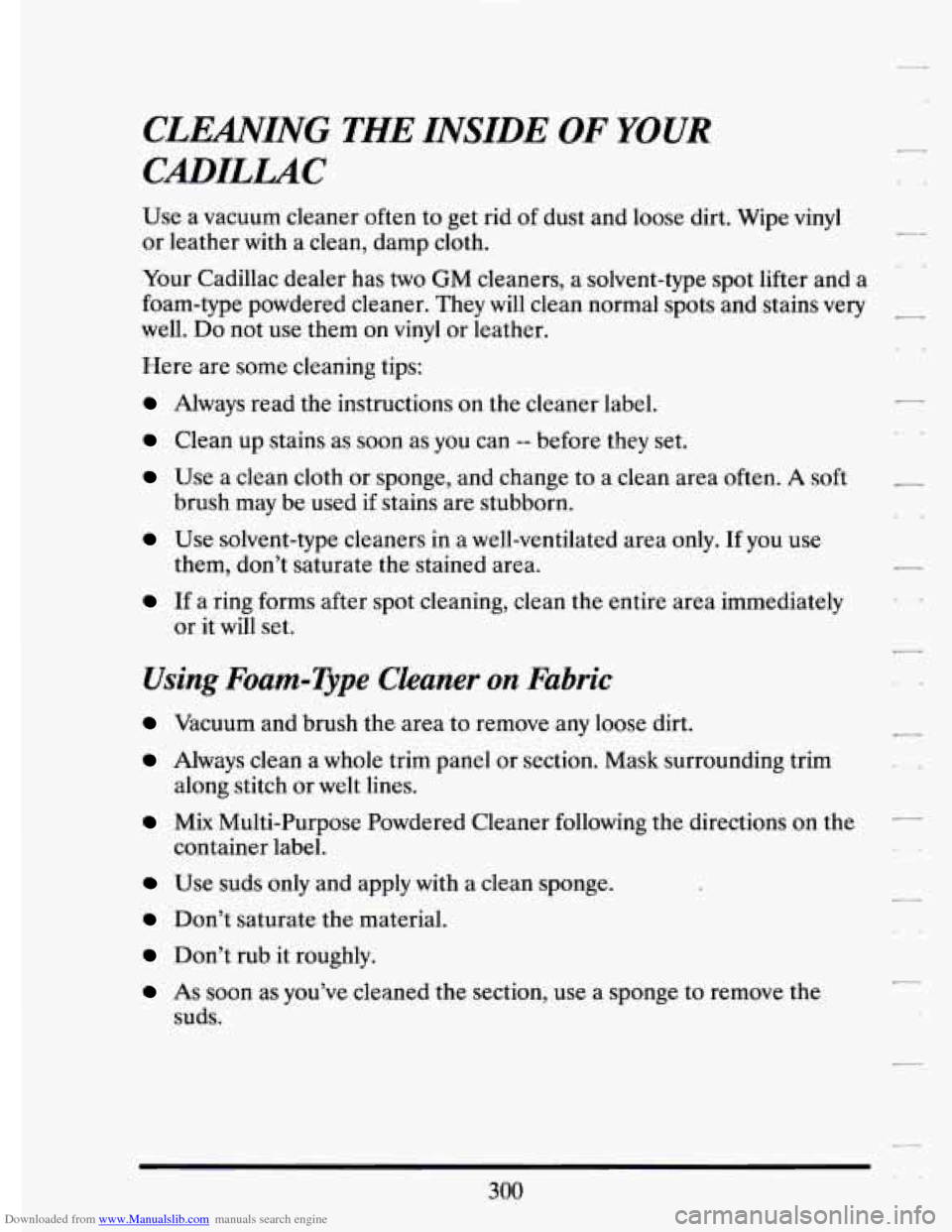
Downloaded from www.Manualslib.com manuals search engine CLEANING THE INSIDE OF YOUR
CrnILLU4C
Use a vacuum cleaner often to get rid of dust and loose dirt. Wipe vinyl
or leather with a clean, damp cloth.
Your Cadillac dealer has
two GM cleaners, a solvent-type spot lifter and a
foam-type powdered cleaner. They will clean normal spots and stains very
well. Do not use them on vinyl or leather.
-
Here are some cleaning tips:
Always read the instructions on the cleaner label.
Clean up stains as soon as you can -- before they set.
Use a clean cloth or sponge, and change to a clean area often. A soft
Use solvent-type cleaners in a well-ventilated area only. If you use
If a ring forms after spot cleaning, clean the entire area immediately
brush
may be used if stains are stubborn.
them, don’t saturate the stained area.
or it will set.
Using Foam=Type Cleaner on Fabric
Vacuum and brush the area to remove any loose dirt.
Always clean a whole trim panel or section. Mask surrounding trim
along stitch or welt lines.
Mix Multi-Purpose Powdered Cleaner following the directions on the
Use suds only and apply with a clean sponge.
container
label.
Don’t saturate the material.
Don’t rub it roughly.
As soon as you’ve cleaned the section, use a sponge to remove the
suds.
300